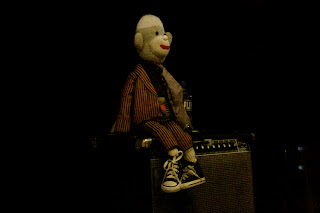What I'd been standing in line for was a long awaited Andrew Bird show. I had attended one last year at the Fourth Presbyterian Church, which was quite good, but I hadn't gotten the Bird fix I needed. This year's show, which took full advantage of the Museum, was far more of a happy combination of both art and music.
As much signature to Andrew Bird as carefree head-shaking and performing barefoot, the Sonic Arboretum, as the installation is know, focused on Bird's idiosyncratic gramophone-like horn speakers (made by Ian Schneller), and how arrangement of sound can come to affect surroundings.
The show itself was quite good. Bird announced preemptively that he was a tad sick (I'd guess on account of the weather), and apologized if he had to turn to instrumental pieces only. Somehow, with the help of copious glasses of water, he pulled through, dishing out favorites like Skin Is My, Plasticities, Tables and Chairs, Lazy Projector, It's Not Easy Being Green, and something I deeply regret not to have recorded- Effigy. The open floor provided plenty of room to move around and, of course, to creep closer and closer to the stage. The horn speakers did their work as well, occasionally bursting with sound and surrounding the audience with Bird's crooning and layered instrumentals. It was a relatively short performance, but a great one. And Bird definitely deserved a full bottle of Nyquil for being able to squeeze out an encore.
The installation was rightfully stunning even long after the show had ended. As intended, the gallery of the MCA was open to wander through as recordings of Bird playing vague instrumental tunes and harmonizing (recorded earlier by Bird in the same museum) seemed to both lead and accompany visitors through every room, while still retaining their own presence. A very particular effect was achieved. Bird himself puts it best:
"As a composer, I am interested in how one's environment and the scale of a landscape affect one's musical imagination; how seeing a storm approach, pass overhead and continue eastward can calibrate the mind to hear music beyond the 8 bar phrase. How the surrounding walls of sand stone at Zion National Park provoke their own frequencies, or the wind strumming through a field of prairie grass has its own phrasing. A steamy mossy forest in the northwest has a certain grain and texture." (Event Pamphlet)
This really did give a walk through the gallery far more dimension than one in silence, and seemed to seamlessly tie the installation in with the regular works. Schneller's speakers were a work of art on their own, serving both a stellar aesthetic and auditory purpose. If anything, the Sonic Arboretum was a sensory wonder.
(As a side-note, I strongly suggest a listen to a recording of Bird's live show at the Rio Theater earlier this year.)





























































